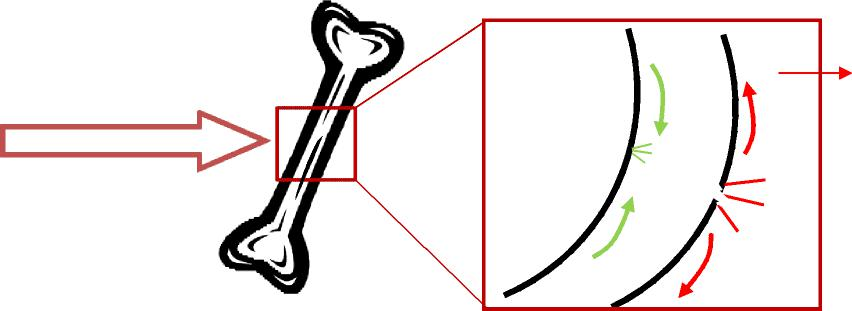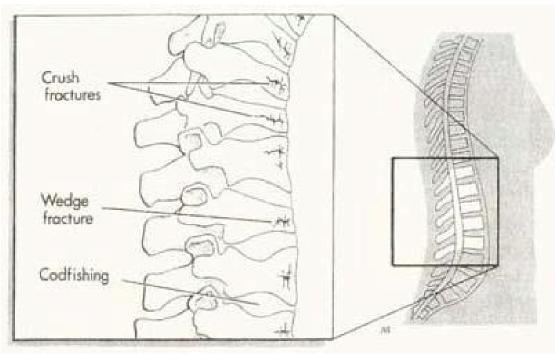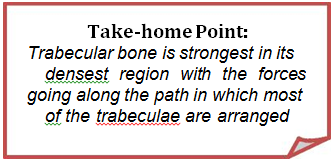Mechanical Behaviour of Bone Copy
You can certainly imagine that your daily activities result in all kinds of forces placed on the body – every change of position results in some type of force being transmitted through your bones and joints. Therefore, bones are subjected to compressive, tensile and shear stresses daily. Occasionally external forces are applied to our bones which are excessive, take for example being hit on the leg by a taxi while trying to cross the street. This could result in a bending load being applied to your tibia. See figure below for what happens on each side of the bone.

Effects of Altered Geometry
As mentioned briefly above, the strength of bone is affected by both age and geometry. During the aging process, bone tissue is resorbed from the endosteal surface and the laid down on the periosteal surface which leads to thinner bones with a larger diameter. So while a thinner bone would be more likely to break, the increase in cross-sectional size can partly compensate for this.
Why is this?? First, the bending strength of a rod varies as the cube of the radius of the rod. Therefore, a change in radius by as little as 1mm can increase the strength by 33%. However, if bones were a solid rod, it would be very strong but too heavy to move. The compromise?..hollow bones with a reasonable diameter.

Fracture Pattern: Bending Force
So we know that if a bending force is applied to a long bone, the failure point is more than likely to be the convex (tension) side. This results in tension failure to occur progressively across the bone creating a transverse fracture. There is a purpose for the bone to fracture – it is the method in which the energy applied during the trauma is dissipated. Therefore it is logical that if a high velocity force is applied to the bone, more energy needs to be dissipated and more cracks in the bone would be generated in the bone to dissipate this energy. Low velocity impacts usually result in a single transverse crack extending 1/3-1/2 of the circumference of the bone, often making unpredictable, oblique angles.
Fracture Pattern: Torsion
Of course injuries to the bones don’t always occur by bending but by twisting forces, such as can happen when a foot is fixed and the body falls or rotates forcefully, for example a fall while skiing. The resulting torsional load on the tibia in this case produces a constant moment throughout the long bone since the moment applied to the fixed segment (in the ski boot) is the exact magnitude but in the opposite direction as the moment closer to the knee joint.
Generally the pattern of the torsional fracture is thus a spiral which is perpendicular to the maximum tensile strength applied. Similar to the bending fracture pattern, loads that are rapidly applied produce more fracture lines – a double spiral pattern.
Fracture Pattern: Compression
Compressive loading involves the application of equal and opposite loads into the structure, resulting in compressive stress and strain within the structure and a resulting shortening and widening of that structure. If the load is applied on the plane perpendicular to the object surface, this results in maximal compressive stress. As the vertebrae are subjected to high compressive loads under normal circumstances, it is expected that these bones in particular would be susceptible to undergoing compressive fractures. In other joints, compression fractures can be elicited with abnormally high muscular contraction forces around the joint. Although this doesn’t typically apply to a vertebral segment, consider the effect of repeated, high muscular work on one aspect of the vertebrae and that contribution to developing vertebral fractures.23
Typical patterns of vertebral fractures include crush and wedge fractures. Crush fractures occur in the condition in which compressive forces are distributed nearly equally throughout the entire vertebral body, thus causing an equal loss of height throughout the entire vertebral body. Wedge fractures, on the other hand, are generally a result of accentuated compressive forces on one aspect (most typically anterior) of the vertebral body, resulting in a more wedge shaped vertebra. (see Figure 1 – adapted from STAND TALL by Morris Notelovitz, M.D. Triad Publishing, Gainesville, Florida)

FIGURE 1 – examples of vertebral fracture patterns
Affect of Aging on Cortical & Trabecular Bones
Cortical Bone:
The affect of aging results in cortical bone’s diminishing ability to resist fracture. Elastic properties decrease somewhat but it is the toughness and strength of the bony material which diminishes even more so. Research has revealed that the stiffness of femoral cortical bone reduces 1-2% per decade after 35 years old, while maximum stress (strength) decreases 2-5% per decade2,28. Most significantly the toughness of cortical bone (the energy to fracture) decreases 10% per decade which means that lower energy events impacting the bone in the older persons would result in a fracture which would not occur similarly in a younger person. In addition, cortical bone is porous to begin with and this porosity increases significantly with age.17

Trabecular Bone:
Trabecular, or cancellous, bone strength is dependent largely upon the density of its trabeculae – according to some research, this accounts for approximately 60% of the variance in strength in sites around the body.9 Since trabeculae are arranged in different patterns within bone, if forces are directed through the bone trabeculae along its’ principal orientation, strength variance rises to 90%.

With aging in both men and women, the apparent density of trabecular bone decreases significantly and thus, the strength of the bone is proportionately decreased.18,21 Its been reported that the compressive strength of vertebral trabecular bone decreases between the ages of 25-75 year by 70% and proximal femoral trabecular bone loses 50% of its strength in the same time span.18 Accounting for this loss of strength is a reduction in the thickness and number of individual trabeculae, resulting in a loss of density.8,9
Whole Bone Changes with Age:
With age, the proximal femur undergoes significant loss of structural integrity, thus leaving it vulnerable to damage under low force conditions. Research comparing younger and older femoral specimens revealed that in the older specimens there was a reduction of strength by 50%, stiffness by 30% and overall toughness by 70%.4
Similarly, vertebrae also undergo age-related changes in strength which are particularly related to the density and strength of the vertebral trabecular bone. Between the ages of 30 and 90, compressive strength of the vertebrae decreases by 80%.5